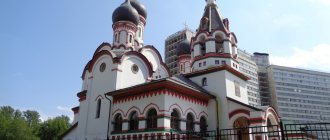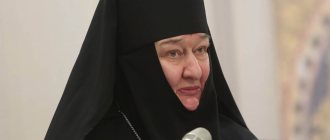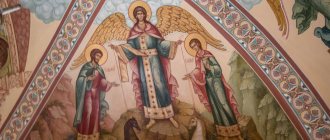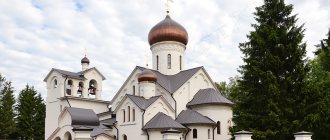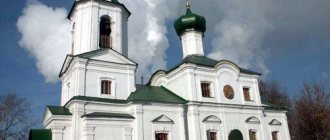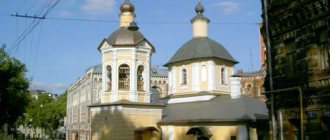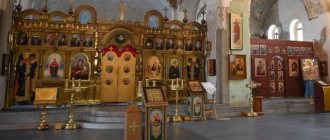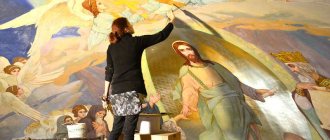| Trinity Church at the former Bakhrushin shelter, October 23, 2014 |
Church in honor of the Life-Giving Trinity at the former shelter of the Bakhrushins in Sokolniki
(Trinity Deanery of the Moscow Diocese)
- Thrones: Holy Trinity, Alexy, Man of God, Adrian and Natalia
- Address: Russia, Moscow, 1st Rizhsky lane, building 2, building 7
- Official site:
- On the map: Yandex.Map, Google map
The Church of the Life-Giving Trinity was planned and built as the central part of an architectural complex: a free shelter for the brothers Peter, Alexander and Vasily Bakhrushin, intended for orphan boys. A plot of land for the construction of a “shelter for children abandoned by their parents” was allocated in 1895 by the Moscow city government at the request of Moscow merchants Peter, Alexander and Vasily Alekseevich Bakhrushin. On the site provided by the city, the Bakhrushins erected ten buildings: a church, seven one-story residential buildings for housing students, a two-story educational and production complex in which workshops were located and training took place, and another, also two-story, administrative building with an office, infirmary, refectory and apartments, in where the director, teachers and their families lived.
| Trinity Church at the former shelter of the Bakhrushins, photo ca. 1900, from the book “Moscow City Institutions Based on Donations and Capital” |
On May 18, 1903, the consecration of the temple took place.
To celebrate the tenth anniversary of the shelter in 1911, the temple was painted in three and a half months by artists from the studio of Pavel Pavlovich Pashkov based on the compositions of Viktor Vasnetsov from the Vladimir Cathedral in Kyiv. During Soviet times, the walls of the temple were completely plastered, but the paintings were preserved under the plaster in relatively good condition. This is evidenced by trial openings of paintings in different parts of the church.
During the years of Soviet power, the temple was closed, the domes of the temple and the bell tower were demolished, the Russian-style porch was destroyed, and the building itself was redeveloped.
On January 28, 1999, the temple was transferred to the Church. In 2000, worship resumed there.
Patrons
Family P.A.
Bakhrushina: standing from left to right - A.P. Bakhrushin, K.P. Bakhrushin, N.P. Bakhrushin; sitting from left to right - P.A. Bakhrushin, E.I. Bakhrushina, D.P. Bakhrushin. Photo from the 1880s The Bakhrushin family of industrialists and entrepreneurs was known for charity: with their money, hospitals and houses for the poor were built throughout Moscow, temples and churches were erected, schools, theaters and museums were opened. In total, thanks to the efforts of the brothers-philanthropists, about 100 social institutions appeared in the capital. The Bakhrushins spent about 6 million rubles on their construction and maintenance, for which in 1901 they received the title of hereditary Honorary Citizens of the city of Moscow.
Bakhrushin Shelter
Bakhrushinsky Orphanage, 1913-1914. Photo: “Album of buildings belonging to the Moscow City Public Administration”
In 1903, with the money of the Bakhrushin brothers, a Moscow city social shelter for boys was built in the village of Alekseevskoye (now Alekseevsky district), the charter of which was approved by Emperor Nicholas II himself. This was the first family-type orphanage in Russia. Orphans from the age of 4-6 were accepted into the Bakhrushinsky orphanage. There they lived for 15-20 people in six separate houses under the supervision of teachers and nannies. Children were raised according to the system of the German teacher Friedrich Froebel, who coined the term “kindergarten”. In the lower grades, orphans were taught arithmetic and grammar, in the older grades - carpentry, carpentry and plumbing. The students left the orphanage at the age of 18, but only after they found work.
Former Bakhrushinsky shelter in the village of Alekseevskoye in Moscow
Not far from the Alekseevskaya pumping station there are buildings of the former shelter of the Bakhrushin brothers (Bakhrushinsky shelter) . Today it is in disrepair; the high-rise buildings in the neighborhood somewhat obscure the appearance of this beautiful red brick ensemble.
* Tour organizer: “Noble estates. Podmoskovnye.ru"
Former Bakhrushinsky shelter
The Bakhrushins are a famous Moscow dynasty of entrepreneurs and philanthropists. In Moscow and the Moscow region, hospitals, shelters, schools, churches, theaters, museums - about 100 objects in total - were built with the Bakhrushins' funds. The Bakhrushins spent about 6.5 million rubles on their construction and maintenance. In 1901, for their active charitable activities, Alexander and Vasily Alekseevich Bakhrushin received the rare title of “Honorary Citizen of the City of Moscow” at that time.
♦ On topic: A selection of excursions around Moscow: popular, sightseeing, unusual, literary, gastronomic…
Alekseevskoe village. Moscow city orphanage named after brothers Peter, Alexander and Vasily Alekseevich Bakhrushin
The Bakhrushinsky orphanage was founded in 1896 in the village of Alekseevskoye near Moscow (now within Moscow). Its Charter stated: “the orphanage has the purpose of providing free religious, moral and physical education and practical vocational education to poor male children abandoned by their parents.” The Bakhrushins donated 600 thousand rubles for it. Of these, 150 thousand were intended directly for construction, and the remaining amount (450 thousand) was deposited at interest for the maintenance of the shelter. Here children lived from the age of 4-6, received a general education and mastered a profession.
View from the Shelter Temple towards the alley. Bedrooms and a dining room for children (1900, architect Karl Gippius). A game of croquet. Author: P.P. Pavlov. Photo from the “Album of buildings belonging to the Moscow City Public Administration”
The complex of buildings of the Bakhrushinsky shelter was built in 1901 according to the design of the famous Moscow architect Karl Karlovich Gippius. In the center stands the Church of the Life-Giving Trinity , consecrated in 1903.
Church of the Life-Giving Trinity at the former shelter of the Bakhrushins, 1901-1903
Church of the Life-Giving Trinity in the village of Alekseevskoye, fragment
Church of the Life-Giving Trinity in the village of Alekseevskoye, fragment
Church of the Life-Giving Trinity in the village of Alekseevskoye, fragment
Around the church there were five one-story houses, each of which housed 20-25 people. Alas, today they are in an abandoned state.
A complex of two one-story buildings of the former Bakhrushinsky orphanage (1st Rizhsky lane, 2, buildings 5 and 6)
Former Bakhrushinsky shelter
Two one-story buildings of the former Bakhrushinsky orphanage (1st Rizhsky lane, 2, buildings 9 and 10)
One of the buildings of the former Bakhrushinsky orphanage
At the request of the brothers, the orphanage became the property of the city and received the name “Moscow City Orphanage named after the brothers Peter, Alexander and Vasily Alekseevich Bakhrushin . Nikolai Vasilyevich Nesmeyanov, the father of Academician Alexander Nikolaevich Nesmeyanov (1899-1980), a famous chemist, president of the Academy of Sciences and rector of Moscow University, was appointed director.
Former Bakhrushinsky shelter
With the donations of Vera Fedorovna Bakhrushina, a two-story administrative building was built. An office, a parable house, an infirmary and apartments for employees and the rector of the temple were located here. In 1910, according to the design of the architect Nikolai Nikolaevich Blagoveshchensky, an educational building was built, where electromechanical and artistic metalworking workshops were located.
A former hospice hostel with an almshouse, now the Mir publishing house
Former hospice hostel with almshouse, fragment
Abandoned building
After 1917, an orphanage was opened in the former Bakhrushinsky orphanage, then an orphanage named after the Communist International, where orphans from Spain were raised. Now most of the buildings of the former shelter are abandoned, one of them houses the Mir publishing house.
♦ On the topic: Is it easy to travel around Russia?
Abandoned building of the former Bakhrushinsky orphanage
The building of the publishing house "Mir" of the former Bakhrushinsky orphanage
Nowadays, the buildings of the Alekseevskaya pumping station and the Bakhrushinsky shelter constitute a single historical and architectural complex. I would like to hope that this is not just a formality; the buildings of the former shelter will be restored to their original form.
Directions: metro station "Alekseevskaya" Kaluzhsko-Rizhskaya line, then on foot.
© Website “On the Roads of the Middle Way”, 2009-2021. Copying and reprinting of any materials and photographs from the site anashina.com in electronic publications and printed publications is prohibited.
Temple in the name of the Life-Giving Trinity
Orphanage and Church of the Life-Giving Trinity, 1913-1914. Photo: “Album of buildings belonging to the Moscow City Public Administration”
The temple at the Bakhrushinsky shelter was erected in 1903. It was painted in the Russian-Byzantine style and richly decorated. After the October Revolution, the temple was looted, the temple domes and bell towers were demolished, and the walls and vaults were covered with paint. In 1929, the church was remodeled into a dormitory for students of the factory school, and the Comintern shelter housed immigrant children taken from Spain in the former orphanages. After the war, the entire complex of buildings, transferred to the Mir publishing house for foreign literature, gradually fell into disrepair.
In 1999, the shelter church began to be restored, and it began to acquire its original architectural appearance. They also restored the historical 50-meter bell tower: in 2021, the dome was returned to its place, and a year later, 14 bells were raised to the new belfry of the temple. The weight of the largest bell of the Blagovestnik type is almost 1.5 tons, and the smallest is 4 kg.
Cathedral architecture
As already mentioned, the temple is made in the spirit of the Vladimir-Suzdal school of architecture. The style is distinguished by strict forms and a minimal number of decorative elements. It is also characterized by high white walls with narrow windows and onion domes covered with gold or painted blue. This unusual project was developed by Yuri Panteleimonovich Grigoriev, People's Architect of the Russian Federation.
The church is four-pillared, rectangular . Its first floor consists of three parts: a vestibule with a candle box, a temple part and an altar. Like many ancient churches, the altar part of the temple is formed by three apses. In the basement there is a sacristy and various utility rooms. The church is crowned with five golden domes, symbolizing Christ and the four evangelists.
However, the temple has one significant difference from ancient buildings. It was not built from white limestone blocks, like pre-Mongol churches, but from completely modern materials. Its basis is a strong reinforced concrete structure, which is lined with brick on the outside.
At the same time as the church, a two-story parish house was erected. It houses various administrative offices, recreation rooms, Sunday school classrooms, and a refectory .
Electronic belfry
Installed bell. Photo: sv-troitsa.ru
Bells before installation. Photo: sv-troitsa.ru
Bells are raised to the new belfry of the Temple, September 5, 2021. Photo: sv-troitsa.ru
An electronic belfry was installed at the new bell tower of the Church of the Life-Giving Trinity at the Bakhrushin shelter. Now the clergy do not need to climb to a 50-meter height, but simply dial a certain combination of numbers on their mobile phones - and immediately the blessed church chimes are heard throughout the area. A special computer program has a database of 80 melodies and a wide variety of sound shades - both for everyday life and for festive occasions. To the ear, electronic ringing is no different from live ringing. However, according to the rector of the temple, the bell ringer will still appear in the temple, and then the remote control will only be his assistant.
Social activities in the church
Every day more and more new parishioners appear in the church on Svyatoozerskaya. At the same time, the activities of the community are by no means limited to visiting church. Many parishioners take an active part in social and missionary activities and organize all kinds of festive and cultural events.
For example, the church runs a free Sunday school for children seven years old and older. Her classes are held on Saturdays and Sundays. During the lessons, young parishioners study the Old and New Testaments, become acquainted with the fundamentals of the Orthodox faith, the history of the Christian church and Orthodox worship.
Also available for children:
- theater Club;
- piano courses;
- solfeggio courses;
- folklore singing studio;
- choreography circle.
The children's choir actively participates in holiday concerts and services.
There is a youth group for older parishioners. Her goal is to help young men and women
gain experience of Christian life in the modern world. and at the same time learn not to follow his lead. Young people are engaged in social service, moral and spiritual development, and participate in cultural and sporting events.
Adult parishioners also have their own Sunday school. Her classes are held on Tuesdays at 7:00 pm and feature fascinating conversations about the basics of the Christian faith and spiritual life. Anyone can take part in them .
The church community regularly helps people who find themselves in difficult life situations. In particular, she organizes meetings and conversations with alcohol addicts, and in the church itself weekly prayer services are held near the “Inexhaustible Chalice” icon of the Mother of God.
In addition, the temple regularly hosts:
- Public conversations with future godparents.
- Sunday parish consultations.
- Ceremonial events and concerts in honor of church and secular holidays (Maslenitsa, Victory Day).
- Sunday tea parties for everyone (immediately after the liturgy).
Commemorations and magpies are accepted in the church shop. Here you can also purchase Orthodox literature, CDs with Christian music and films, as well as icons and various church utensils.

